Bryan L. Programmable controllers. Theory and implementation
Подождите немного. Документ загружается.


579
CHAPTER
13
Data Measurements
and Transducers
Industrial Text & Video Company 1-800-752-8398
www.industrialtext.com
SECTION
4
PLC Process
Applications
EXAMPLE 13-6
A thermistor has a resistance value of 100 KΩ at 3°C and a β constant
of 3900°K. At what temperature (°C) will the thermistor’s resistance be
20 Ω?
S
OLUTION
The value of
T
0
is equal to 3°C. This translates to an absolute
temperature value of 276°K (3°C + 273°). So, when
R
T
equals 20 KΩ,
the temperature will be 311.5°K:
RRe
TT
e
T
e
T
T
T
=
−
=
−
=
−
(
)
=
−
(
)
−=
0
0
3900
3900
11
20 100
11
276
02
1
0 00362
0 2 3900
1
0 00362
1 609
β
..
ln . .
.
39003900
1
0 00362
0 000413
1
0 00362
1
0 00321
311 5
T
T
T
T
−
(
)
−=−
=
=°
.
..
.
.K
Therefore, the temperature in °C is:
311 5 273 38 5..°− °= °KK C
THERMOCOUPLES
Thermocouples are bimetallic temperature measuring devices (i.e., they
are made of two different metals). In a thermocouple, the two metals are
joined together at junctions with different temperatures (see Figure 13-15).
This temperature differential creates a voltage across the thermocouple—a
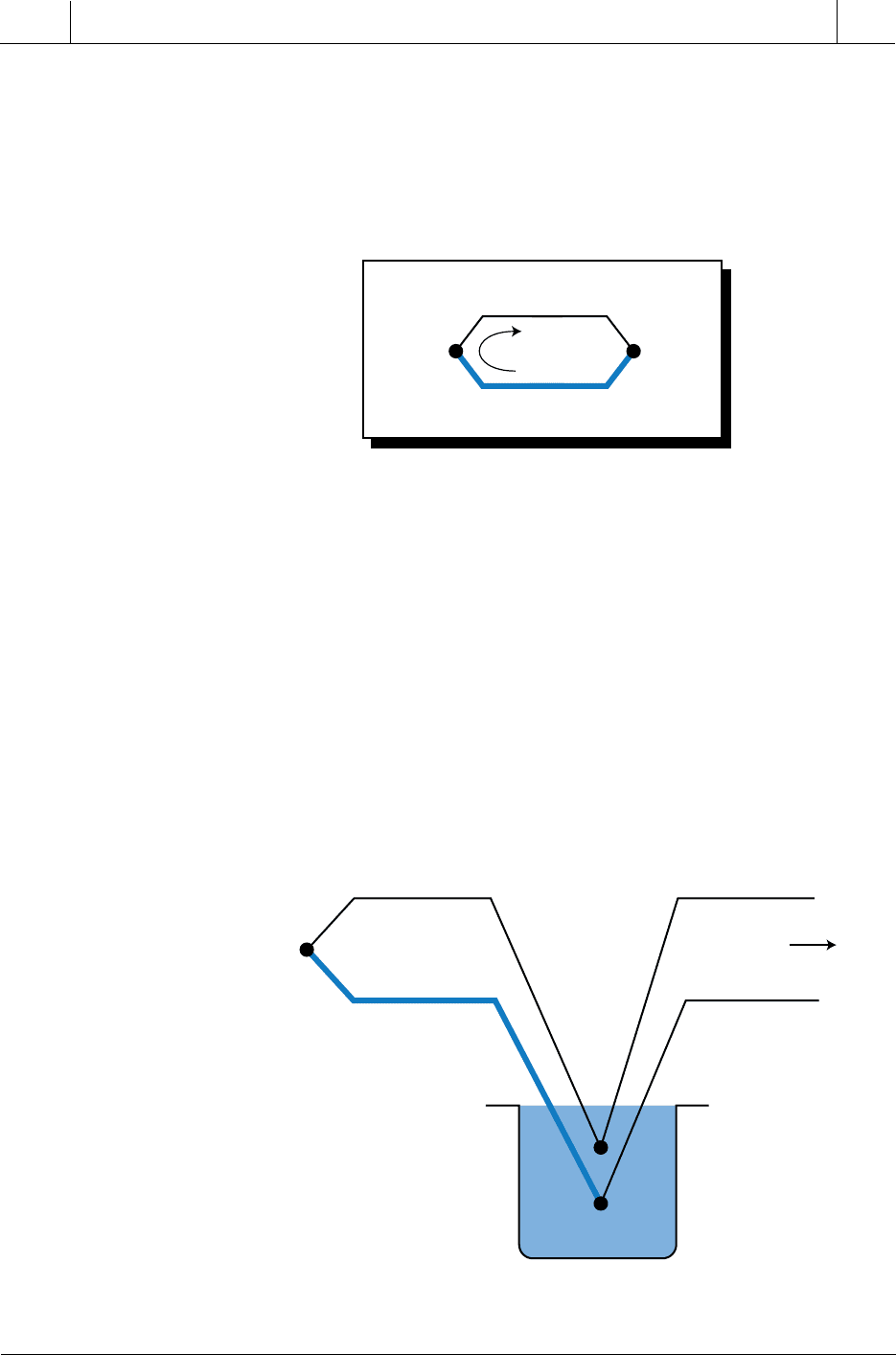
580
SECTION
4
PLC Process
Applications
Industrial Text & Video Company 1-800-752-8398
www.industrialtext.com
CHAPTER
13
Data Measurements
and Transducers
phenomenon known as the Seebeck effect. Temperature T
1
, the hot junction,
is the temperature being measured, while T
2
, the cold junction, is the reference
temperature. As temperature T
1
increases, the voltage differential (emf)
between materials A and B increases in proportion to the temperature. Table
13-6 compares the characteristics of different types of thermocouples.
Figure 13-15. Thermocouple diagram.
The standard reference junction (cold junction) temperature for a thermo-
couple is 0°C; therefore, all standard tables list thermocouple voltage outputs
based on a 0°C cold junction reference. Figure 13-16 graphically illustrates
how to use an ice bath to keep the reference junction at 0°C. Although in
theory the reference junction should be at 0°C, this is certainly not practical
in industrial applications. Therefore, to implement thermocouple readings
based on the standard tables (0°C reference), the user must perform a cold
junction compensation. Cold junction compensation factors the effect of the
nonzero reference temperature into the output voltage reading so that a
standard thermocouple table can be used to find the hot junction temperature.
Let’s look at an example to see how this compensation is performed.
Figure 13-16. Thermocouple kept at 0°C in an ice bath.
Hot
Junction
Cold
Junction
Material B
Material A
T
2
T
1
emf
Hot
Junction
Material B
Material A
Cold
Reference
At 0°C
Ice Bath
CU
CU
To
PLC

581
CHAPTER
13
Data Measurements
and Transducers
Industrial Text & Video Company 1-800-752-8398
www.industrialtext.com
SECTION
4
PLC Process
Applications
Table 13-6. Thermocouple comparisons.
(From the
Instrument Engineer’s Handbook: Process Measurement
)
epyTASI
noitangiseD
evitisoP
eriW
evitageN
eriW
repstlovilliM
°F
muminiM
(pmeT ° )F
mumixaM
(pmeT ° )F
elacS
ytiraeniL
dednemmoceR
tnemnorivnE
segatnavdAsegatnavdasiD
B03hR-07tP6hR-49tP600.0–3000.0230833
hgihtadooG
roop;spmet
0001woleb°F
wolsrotrenI
gnizidixo
––
ElemorhCnatnatsnoC240.0–510.0023–0381dooGgnizidixO/fmetsehgiH°F
nahttfirdregraL
esabrehto
sC/Tlatem
JnorInatnatsnoC530.0–410.0023–0041
ylraen;dooG
–003morfraenil
008°F
gnicudeR
tsoM
lacimonoce
–
KlemorhClemulA420.0–900.0013–0052
tsom;dooG
sC/Tllaforaenil
gnizidixOraeniltsoM
evisnepxeeroM
TroJnaht
R31hR-78tPmunitalP800.0–300.000013BepytsaemaSgnizidixO
tsaf,ezisllamS
esnopser
evisnepxeeroM
Kepytnaht
S01hR-09tPmunitalP700.0–300.000023BepytsaemaSgnizidixORepytsaemaS
evisnepxeeroM
Kepytnaht
TreppoCnatnatsnoC530.0–800.0013–057
tub,dooG
woltadedworc
dne
rognizidixO
gnicuder
dooG
otecnatsiser
morfnoisorroc
erutsiom
detimiL
erutarepmet
YnorInatnatsnoC330.0–220.0002–0081
emasehttuobA
Jepytsa
gnicudeR–
lairtsudnitoN
dradnats
–netsgnuT62eR-47W210.0–100.000024BepytsaemaSmuucavrotrenI
hgiH
erutarepmet
otdrah,elttirB
evisnepxe,esu
–6eR-49W62eR-47W010.0–100.000024BepytsaemaSmuucavrotrenI
hgiH
erutarepmet
elttirbsselelttiL
evobanaht
–reppoC
-dloG
tlaboc
520.0–5000.0054–0
elbanosaeR
06evoba°K
–
tatuptuodooG
wolyrev
erutarepmet
-balevisnepxE
C/Tepyt
–06hR-04rImuidirI400.0–100.000083BepytsaemaStrenI–
,elttirB
evisnepxe

582
SECTION
4
PLC Process
Applications
Industrial Text & Video Company 1-800-752-8398
www.industrialtext.com
CHAPTER
13
Data Measurements
and Transducers
EXAMPLE 13-7
A Chromel-Constantan (type-E) thermocouple has a reading of 16.42
mV at its output. The reference junction is at 46°F (see Figure 13-17).
Find the temperature
T
at the hot junction (i.e., the temperature
being measured). Utilize compensation to obtain the correct tem-
perature reading.
Figure 13-17. Chromel-Constantan thermocouple.
SOLUTION
Since the reference temperature is not at 0°C, we must perform a
cold junction compensation. To perform this compensation, we must
first find the millivolt reading for 46°F from the type-E thermocouple
table (referenced at 0°C, 32°F). Table 13-7 shows relevant values from
this table.
erutarepmeTtuptuOtlovilliM
04°FVm62.0
64°F?
05°FVm95.0
Table 13-7. Excerpt from type-E thermocouple table.
To obtain the millivolt output at 46°F, we must perform a linear
interpolation of the available table values. Referring to Figure 13-18,
we interpolate this value by finding the proportional ratio of the listed
values as follows:
X
X
X
X
−
−
=
−
−
−
=
=+
=
026
059 026
46 40
50 40
026
033
6
10
033 06 026
0 458
.
..
.
.
( . )( . ) .
.mV
Hot
Junction
Cold
Junction
Chromel
Constantan
T
2
T
1
emf
46°F16.42 mV

583
CHAPTER
13
Data Measurements
and Transducers
Industrial Text & Video Company 1-800-752-8398
www.industrialtext.com
SECTION
4
PLC Process
Applications
The value 0.458 mV is an offset value that must be added to the
thermocouple output value to compensate for the cold junction read-
ing. Therefore, the compensated output reading is:
Output=16.42 mV + 0.458 mV
=16.878 mV
To obtain the temperature for a 16.878 mV output, we must return to
the type-E thermocouple table and find the values closest to 16.878
mV. Table 13-8 shows these values. Again, since there is no exact
value for the millivolt reading, we must perform a linear interpolation of
the two known table values. The temperature
T
for the cold junction
compensated output value is:
470 480
16 68 17 10
470
16 68 16 878
10
042
470
0 198
0 198 23 809 470
474 71
−
−
=
−
−
−
−
=
−
−
=+
=°
.. ..
..
(. )( . )
.
T
T
T
T
F
Figure 13-18. Interpolation for compensation example.
erutarepmeTtuptuOtlovilliM
074°FVm86.61
?Vm878.61
084°FVm01.71
Table 13-8. Excerpt from type-E thermocouple table.
°F
mV
50
46
40
0.26
X
0.59
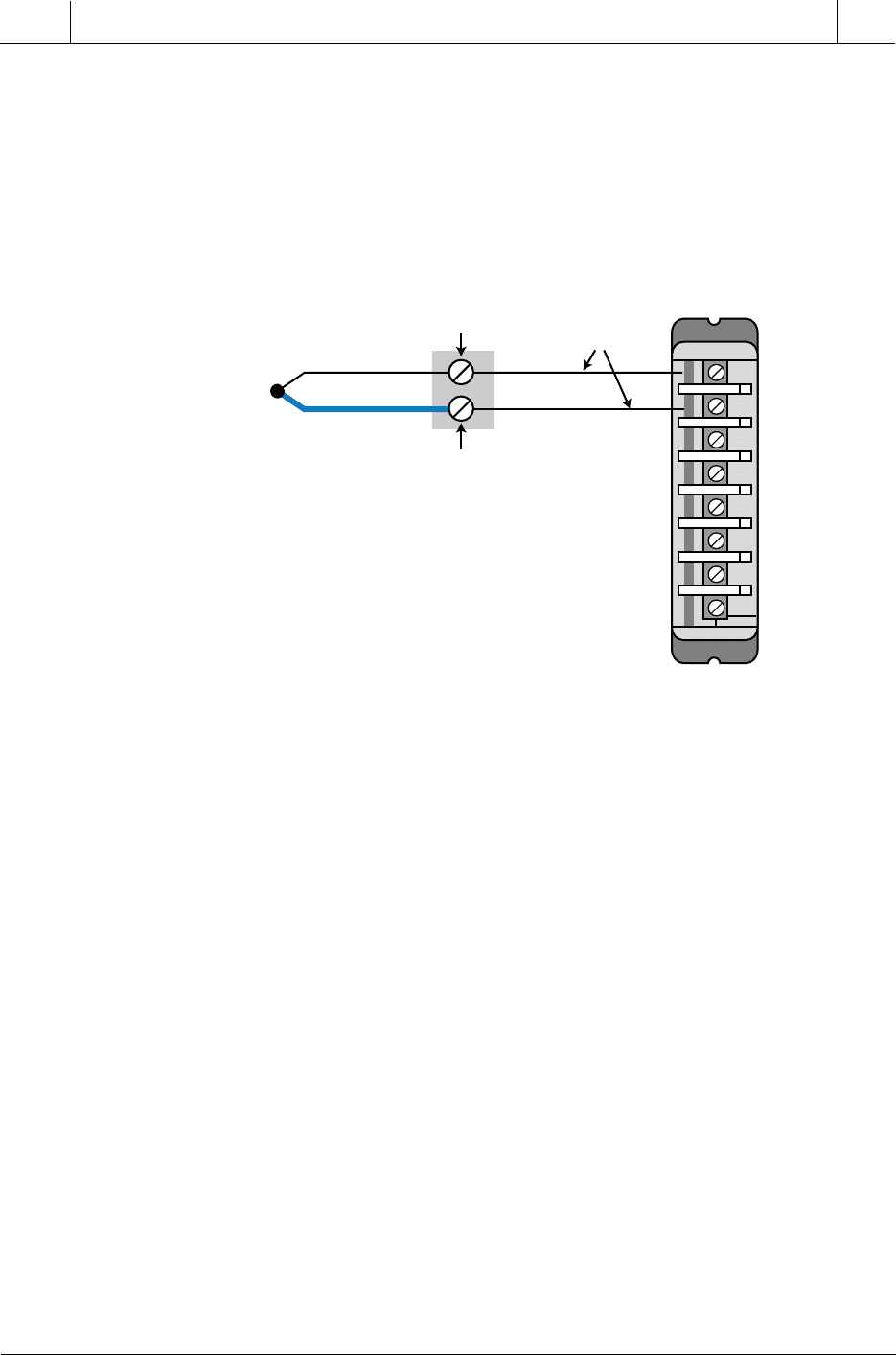
584
SECTION
4
PLC Process
Applications
Industrial Text & Video Company 1-800-752-8398
www.industrialtext.com
CHAPTER
13
Data Measurements
and Transducers
Figure 13-19 shows how thermocouples are connected using lead wires.
Optimally, the lead wires should be made of the same material as the
thermocouple to maintain the thermocouple’s characteristics and to avoid
lead wire resistance. In practice, however, lead wires are usually made of
copper, since wires made of thermocouple materials are expensive and the
distances they must span are generally long. Copper wires provide low
resistance, thus minimizing lead wire resistance.
Figure 13-19. Thermocouple connection diagram.
The temperatures at the reference points of a thermocouple (A and B in
Figure 13-19) must be maintained at the same value. Therefore, special
shielded cable must be used so that the temperature of the cable materials
remains the same all the way to the PLC input. PLCs that have thermocouple
input interfaces provide cold junction compensation at the module, thus
computing any necessary temperature adjustments. A thermistor usually
reads the reference temperature in the module, since the span of the reference
temperature is rather narrow and thermistors provide accurate readings for
narrow temperature ranges. The module’s memory stores all of the thermo-
couple tables.
To increase thermocouple resolution, the user can connect several thermo-
couples in series, thus forming a thermopile. Thermopiles generate larger
output voltages than single thermocouples, which reduces the sensitivity
requirements for the measuring device. When thermocouples are combined
to form a thermopile, they should be clustered together as closely as possible
in order to measure the temperature at a particular point. Figure 13-20
illustrates a thermopiling arrangement. The voltage of the thermopile is the
average of the voltages at the three hot junctions. Note that the thermocouples
Material B
Material A
T
T
Ref
T
Ref
A
B
Lead Wire
1
2
3
4
5
6
7
8
TC 1+
TC 1–
TC 2+
TC 2–
TC 3+
TC 3–
TC 4+
TC 4–
PLC Thermocouple
Input Module
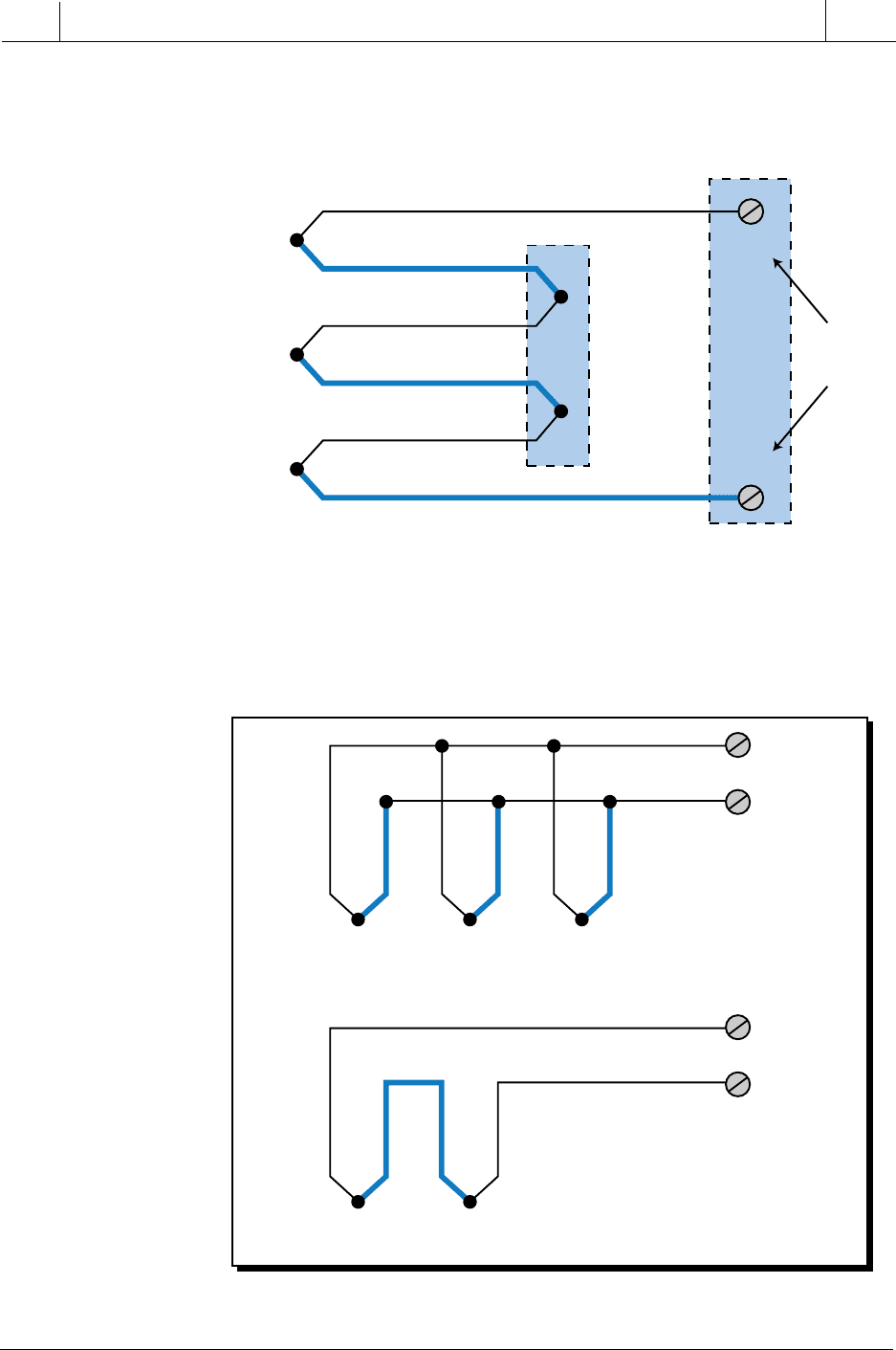
585
CHAPTER
13
Data Measurements
and Transducers
Industrial Text & Video Company 1-800-752-8398
www.industrialtext.com
SECTION
4
PLC Process
Applications
must be isolated from each other to avoid thermal reaction among them, as
well as to avoid a thermocouple emf short. The reference cold junctions must
also be maintained at the same temperature (T
Ref
).
Figure 13-20. Thermopiling arrangement.
Other thermocouple group configurations allow the measurement of tem-
perature differences, as well as direct average readings from several thermo-
couples (parallel thermocouple configuration). Figure 13-21 illustrates these
two configurations.
Figure 13-21. Thermocouple configurations that measure (a) average temperature and
(b) temperature differential.
Hot
Junction 1
Hot
Junction 2
Cold
Junction 2
Cold
Junction 1
Cold
Junction 3
Hot
Junction 3
+
–
+
–
+
–
T
Ref
T
Ref
+–+–+–
To PLC module
(a)
+–+–
To PLC module
(b)
Thermocouples placed at spaced locations to get different
readings. The final reading is the average.
Thermocouples take two readings at two locations, the difference
between the two becomes the input to the PLC.
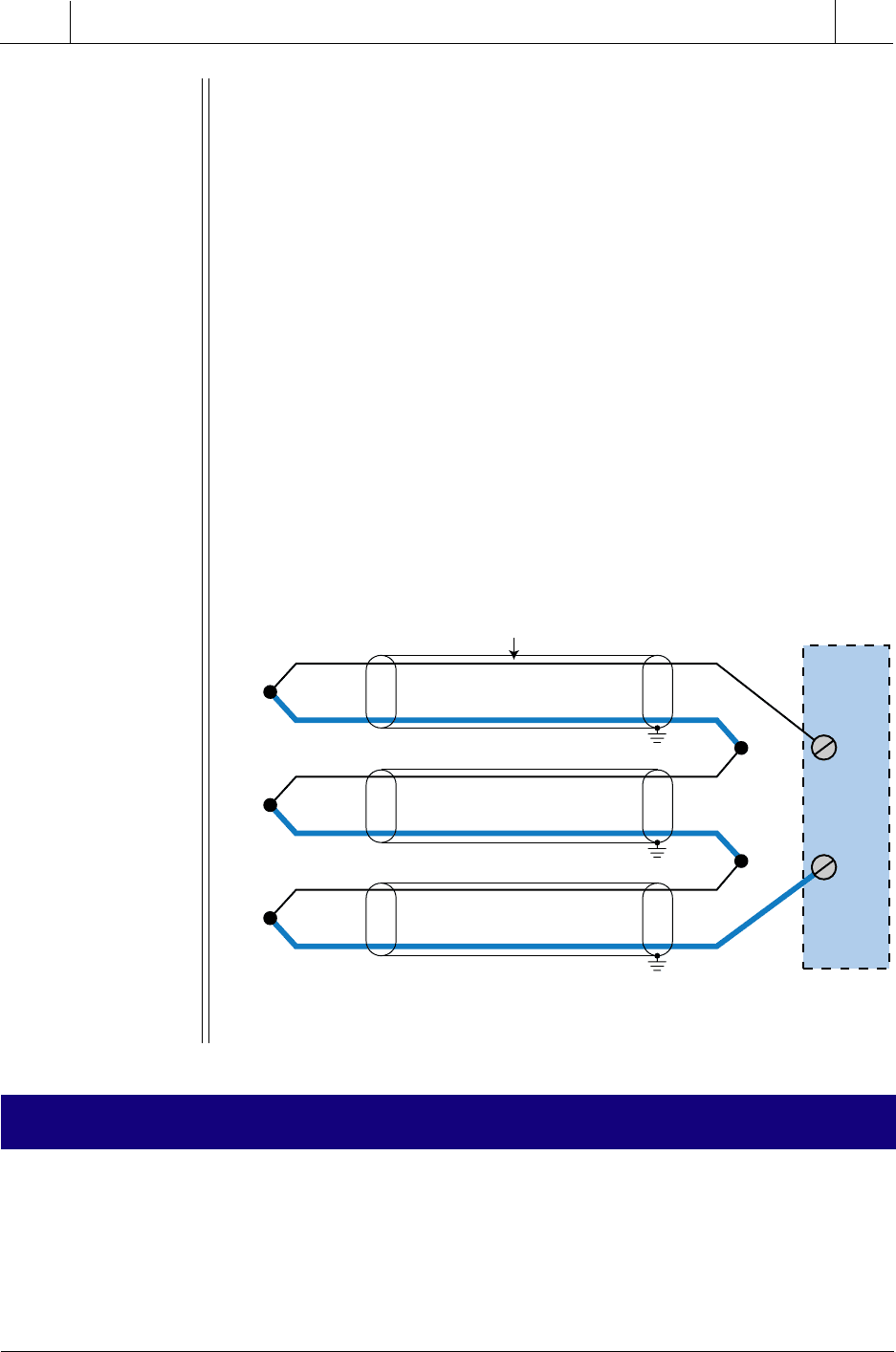
586
SECTION
4
PLC Process
Applications
Industrial Text & Video Company 1-800-752-8398
www.industrialtext.com
CHAPTER
13
Data Measurements
and Transducers
EXAMPLE 13-8
Three type-B thermocouples, which are connected in a thermopile
configuration, will be connected to a thermocouple input module in a
PLC system. The distance from the module to the 2000°F furnace
where the thermocouples are connected is 300 feet. The module’s
measuring thermistor provides cold junction compensation at the
interface. Illustrate the thermopiling configuration and interface con-
nection, indicating the type of cable to be used.
S
OLUTION
Figure 13-22 illustrates a simplified diagram of the wiring configura-
tion. The cable used is type-B shielded cable made of the thermo-
couple material. It runs all the way to the module, since the module
performs the cold junction compensation. Note that all reference
temperatures should be the same.
Figure 13-22. Thermopile wiring configuration.
13-5 DISPLACEMENT TRANSDUCERS
Displacement transducers measure the movement of objects. In this sec-
tion, we will discuss the use of LVDTs and potentiometers as displacement
transducers. Chapter 8 presented other displacement transducers that provide
feedback information, such as encoders and leadscrews. It dealt with these as
position- and motion-related feedback devices.
+
–
+
–
+
–
TC+
TC–
Thermocouple
Interface
Type B
shielded cable
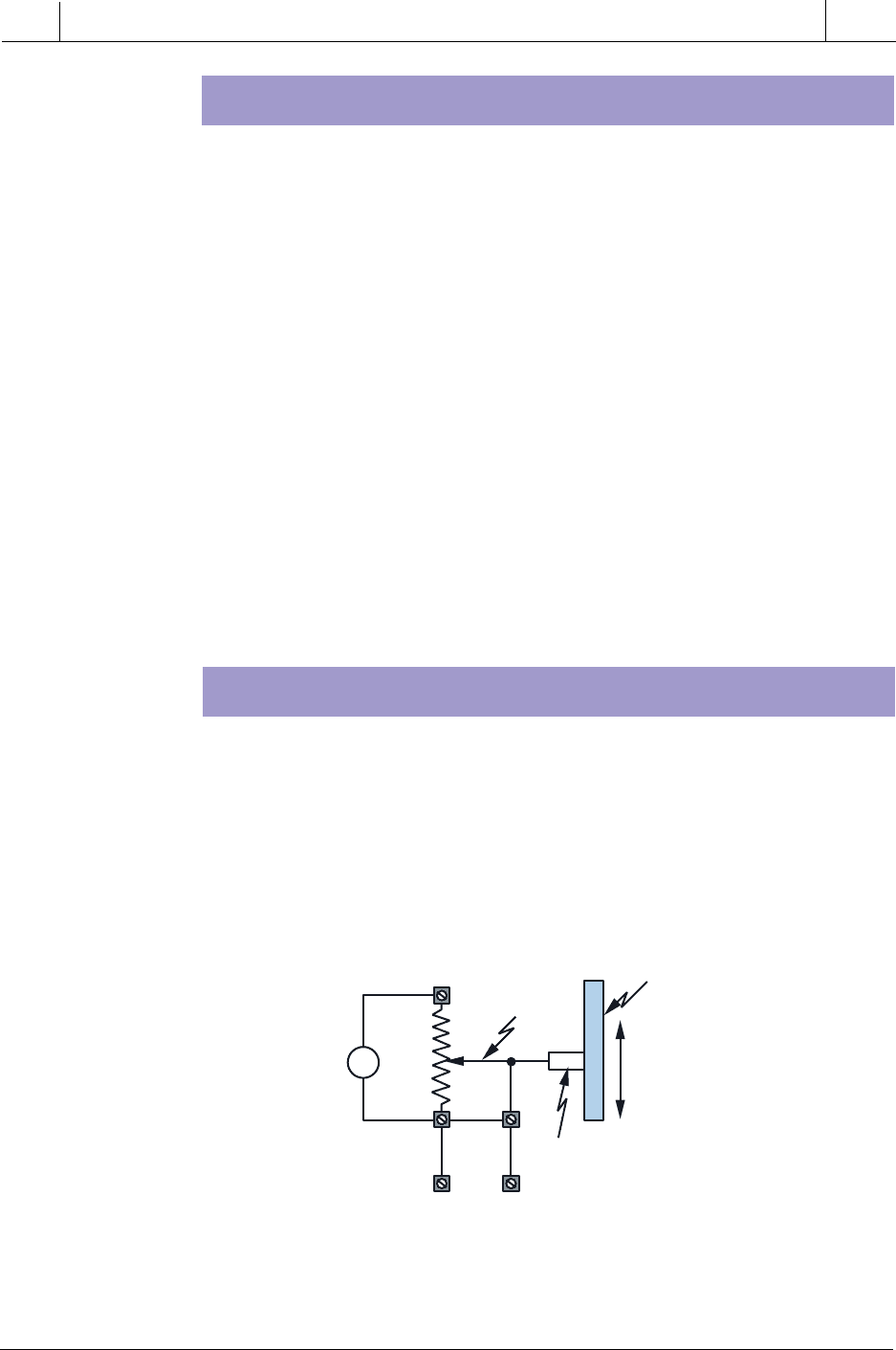
587
CHAPTER
13
Data Measurements
and Transducers
Industrial Text & Video Company 1-800-752-8398
www.industrialtext.com
SECTION
4
PLC Process
Applications
LVDTS
As mentioned previously, LVDTs (linear variable differential transformers)
operate on the principle of a movable core inside a wound coil, which
generates voltage changes depending on the position of the core. Therefore,
the attachment of a rod or a similar element to the core provides a way to
measure linear displacement of the rod along a path.
An LVDT can measure displacement of any type, whether it is induced
pressure, force, or linear displacement. LVDTs are capable of measuring
displacements ranging from ±0.05 inches (±1.27 mm) to ±10 inches (±254
mm). The voltage output from an LVDT is generally ±10 VDC for any
displacement range.
Null repeatability is extremely stable in an LVDT due to the symmetry of the
device. This makes an LVDT an excellent null (0-inch) position indicator for
closed-loop control systems. LVDTs also provide excellent resolution, since
even the most minute movement of the core will produce an output voltage.
This exceptional movement resolution is primarily due to the very low
friction inherent in an LVDT’s design. Chapter 11 provided a programming
and implementation example that included the use of an LVDT.
POTENTIOMETERS
A potentiometer is perhaps the most simple displacement transducer
available. Its measurement principle is based on resistance changes due to the
movement of an arm called a wiper (see Figure 13-23). A voltage source
powers a potentiometer, causing the wiper to provide an output voltage
proportional to the movement of the attached element. This voltage output
corresponds to the voltage drop between the top section of the potentiometer
and the resistance accumulated by the wiper position.
Moving Piece
Movement
Wiper
Wiper Attachment
Voltage
Output
(Position Signal)
+
V
–
Figure 13-23. Potentiometer diagram.

588
SECTION
4
PLC Process
Applications
Industrial Text & Video Company 1-800-752-8398
www.industrialtext.com
CHAPTER
13
Data Measurements
and Transducers
Potentiometer transducers are prone to problems such as excess friction in
the wiper arm, limited resolution in the wire-wound unit, and mechanical
breakdown due to wear. They are also quite sensitive to vibration. On the
other hand, potentiometers have a wide range of applications and are
relatively inexpensive.
13-6 PRESSURE TRANSDUCERS
Pressure transducers transform the force per unit area exerted on their
surroundings into a proportional electrical signal through signal condition-
ing. This measurement can be used simply as a pressure value or as a
means of obtaining other transducer measurements, such as flow, strain,
and vibration.
Three of the most common types of pressure transducers are strain gauges,
Bourdon tubes, and load cells. Bridge circuits usually provide signal condi-
tioning for these pressure transducers. Another type of pressure transducer is
the piezoelectric crystal. However, we will discuss this type of transducer
when we discuss vibration transducers, since it is primarily used for the
detection of vibration.
STRAIN GAUGES
A strain gauge is a mechanical transducer that measures the body
deformation, or strain, of a rigid body as a result of the force applied to the
body. Strain gauges are often used in applications, such as flow measurement,
that require pressure differential measurements. However, strain gauges are
also used in simple direct strain measurements, where stress is directly
applied to a rigid body.
A strain gauge measures pressure by sensing resistance changes in its wires
due to an applied force. These wires are made of either metal, such as copper,
iron, or platinum, or a semiconductor material, such as silicon or germanium.
Strain gauges made of semiconductor material are more sensitive, since they
provide a greater resistance change in response to the deformation caused
by the applied force.
The two main categories of strain gauges are bonded and unbonded, as
illustrated in Figure 13-24. A bonded strain gauge attaches directly to the area
where stress is being applied to the rigid body. A thin layer of synthetic
thermosetting resin (epoxy) connects the bonded strain gauge to the body.
Unbonded strain gauges operate under the same principle; however, a moving
part of the gauge moves with the force applied. This movement changes the
resistance of the wires, creating a voltage differential (due to force) in the
bridge circuit.
